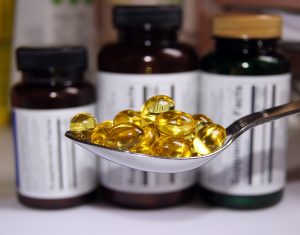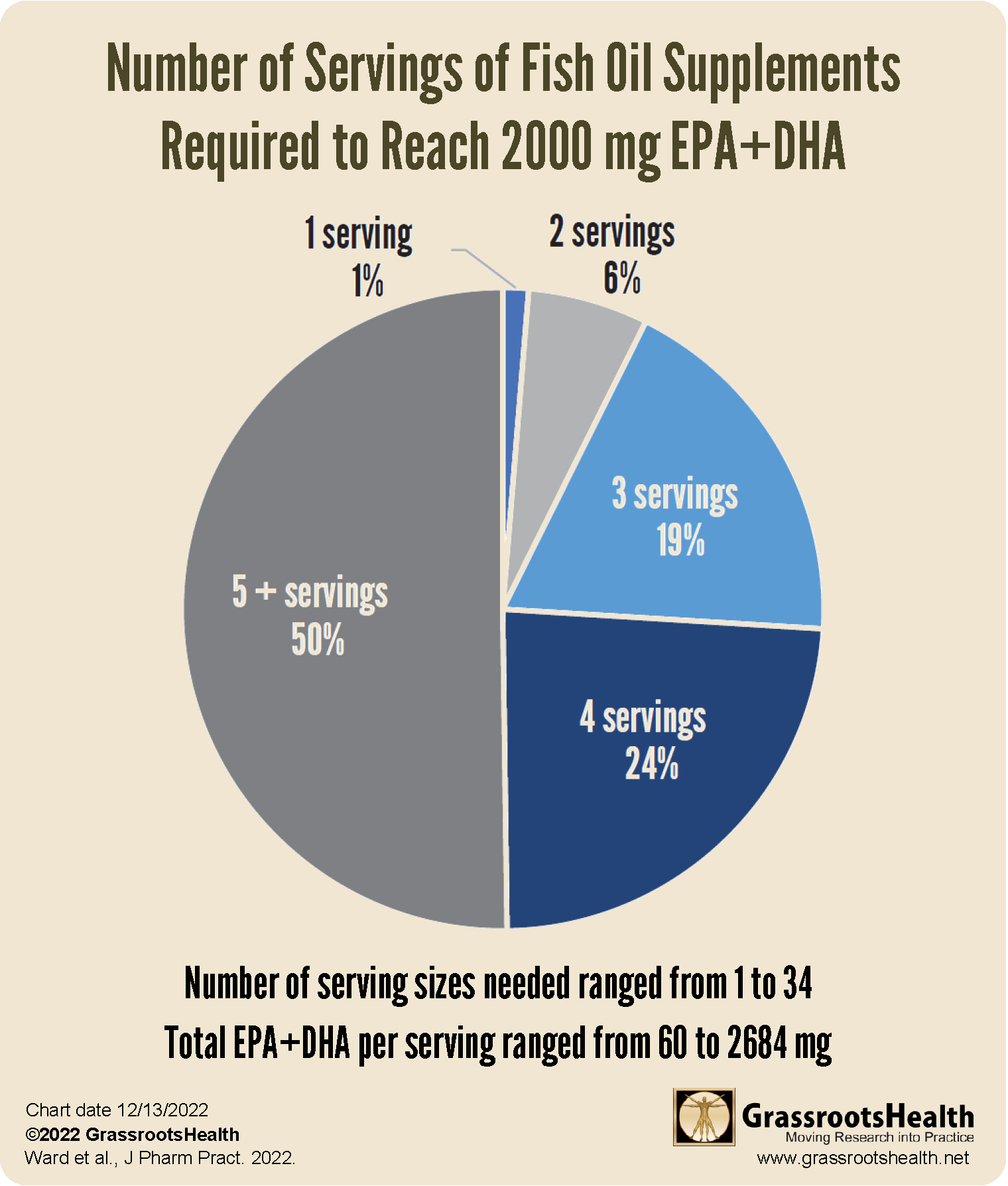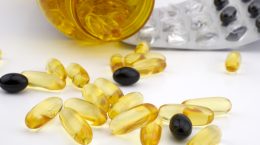Published on December 14, 2022
Could you be taking a fish oil supplement that does not provide nearly enough omega-3s EPA and DHA to benefit your health?
Key Points
- Getting enough omega-3s, primarily eicosapentaenoic acid (EPA) and docosahexaenoic acid (DHA), have been linked to numerous cardiovascular health benefits such as reducing triglycerides, lowering blood pressure, raising HDL-cholesterol, and reducing inflammation; EPA and DHA have also been associated with a reduced risk of anxiety and depression, cancer, asthma, Alzheimer’s disease, type 1 diabetes, multiple sclerosis, and total mortality
- Scientists recommend getting enough EPA and DHA required to reach a minimum Omega-3 Index of 8%; study by GrassrootsHealth showed that the amount of daily EPA and DHA necessary for most people to achieve this level is approximately 1,900 mg per day
- A recent study of 231 fish oil supplements showed that the average total EPA and DHA per serving was 697 mg, with a wide range of 60 to 2684 mg; only two products provided at least 2000 mg of EPA and EPA per serving, with all other products requiring an average of 5 servings, ranging up to 34 servings, in order to obtain that amount of EPA and DHA
 Omega-3 fatty acids are a healthy type of fat that comes in multiple forms. Long-chain omega-3s, primarily eicosapentaenoic acid (EPA) and docosahexaenoic acid (DHA), have been linked to numerous cardiovascular health benefits such as reducing triglycerides, lowering blood pressure, raising HDL-cholesterol, and reducing inflammation. EPA and DHA have also been associated with a reduced risk of anxiety and depression, cancer, asthma, Alzheimer’s disease, type 1 diabetes, multiple sclerosis, and total mortality. Children of women who consume EPA and DHA during pregnancy and nursing have better neurological developmental and other health outcomes. Evidence also suggests that intake of EPA and DHA can help treat symptoms of dry eye disease, lupus, and rheumatoid arthritis.
Omega-3 fatty acids are a healthy type of fat that comes in multiple forms. Long-chain omega-3s, primarily eicosapentaenoic acid (EPA) and docosahexaenoic acid (DHA), have been linked to numerous cardiovascular health benefits such as reducing triglycerides, lowering blood pressure, raising HDL-cholesterol, and reducing inflammation. EPA and DHA have also been associated with a reduced risk of anxiety and depression, cancer, asthma, Alzheimer’s disease, type 1 diabetes, multiple sclerosis, and total mortality. Children of women who consume EPA and DHA during pregnancy and nursing have better neurological developmental and other health outcomes. Evidence also suggests that intake of EPA and DHA can help treat symptoms of dry eye disease, lupus, and rheumatoid arthritis.
How Much EPA and DHA do You Need?
Scientists recommend getting enough EPA and DHA required to reach a minimum Omega-3 Index of 8%. A study by GrassrootsHealth showed that the amount of daily EPA and DHA necessary for most people to achieve this level is approximately 1,900 mg per day. Another study resulted in improved triglyceride levels among individuals taking 2,000-4,000 mg per day of EPA and DHA. Unfortunately, most fish oil supplements don’t contain nearly enough EPA and DHA to achieve these intakes based on their product and serving size.
Study Demonstrates Inadequacy of Many Fish Oil Supplements Based on EPA and DHA per Serving Size
The majority of the population tends to interpret a supplement’s serving size as the suggested daily intake, however, when it comes to fish oil supplements, this may leave the consumer severely lacking in healthy omega-3s.
A new study by Ward et al. analyzed 231 different fish oil products with the above in mind to see which contained at least 2000 mg of DHA and EPA per serving. The authors also considered how many of each (capsules, gummies, etc.) were required to obtain a total of at least 2000 mg EPA and DHA per day.
What Did the Authors Discover?
Of the 231 fish oil supplements, 200 were in the form of capsules (including softgels and gelcaps), 26 were liquids, 4 were gummies, and 1 was a tablet form.
The average total EPA and DHA per serving was 697 mg, with a wide range of 60 to 2684 mg. Only two products (0.9%, both of them liquids) provided at least 2000 mg of EPA and EPA per serving. All other products required an average of 5 servings, with a range of up to 34 servings, in order to obtain that amount of EPA and DHA.
The authors conclude “Serving sizes of fish oil products rarely result in adequate EPA and DHA intake…” They also concluded that the most likely form of fish oil supplement to contain the necessary amounts of EPA and DHA per serving were liquids, with gummies containing the lowest amounts.
“Patients cannot rely on recommended serving sizes provided on natural product labeling to guide them to proper dosing of daily intake of fish oil to achieve health benefits.”
EPA+DHA Content in Supplements Used by GrassrootsHealth Participants
In looking at data from the GrassrootsHealth cohort, participants use a wide variety of EPA+DHA (marine/algal) supplement products. In fact, a previous analysis showed that more than 400 different supplement products were used among the 1092 GrassrootsHealth EPA+DHA supplement users in our study.
Even more surprising to us was how much the amount of EPA+DHA in one serving (based on the product label) differed among the supplement products: 50 to 3,570 mg! The amount of EPA+DHA needed for 50% of our study population to achieve and Omega-3 Index of 8% (~1,300 mg) was found in a single serving of only 14% of supplement products. Furthermore, 7% of products did not provide the amount of EPA and/or DHA on their supplement label.
Are You Getting Enough EPA and DHA from Your Supplements?
Here are some tips on how to read an omega-3 supplement product label.
If, after reading this post, you discover that your omega-3 supplement has insufficient EPA+DHA per serving to allow you to achieve your desired Omega-3 Index, we encourage you to measure your Omega-3 Index and use the Omega-3 Calculator to determine an estimated amount of how much more EPA+DHA you will need to reach an index of at least 8%.
It is important to point out that there is a large amount of variability in the omega-3 status for different people with the same intake amount. For example, according to our study, the range of response with 1000 mg of EPA+DHA per day was 5.7% to 10.2%. This large amount of variability is similar to what we have observed for vitamin D. Therefore, we recommend that individuals measure their Omega-3 Index and determine a personalized dose.
Measure Your Levels Today!
 Having and maintaining healthy omega-3 and vitamin D levels can help improve your health now and for your future. Choose which markers to measure along with vitamin D, such as your omega-3s and essential minerals including magnesium and zinc, by creating your custom home test kit today. Take steps to improve the status of each of these measurements to benefit your overall health. You can also track your own intakes, symptoms and results to see what works best for YOU.
Having and maintaining healthy omega-3 and vitamin D levels can help improve your health now and for your future. Choose which markers to measure along with vitamin D, such as your omega-3s and essential minerals including magnesium and zinc, by creating your custom home test kit today. Take steps to improve the status of each of these measurements to benefit your overall health. You can also track your own intakes, symptoms and results to see what works best for YOU.
Enroll and test your levels today, learn what steps to take to improve your status of vitamin D (see below) and other nutrients and blood markers, and take action! By enrolling in the GrassrootsHealth projects, you are not only contributing valuable information to everyone, you are also gaining knowledge about how you could improve your own health through measuring and tracking your nutrient status, and educating yourself on how to improve it.






